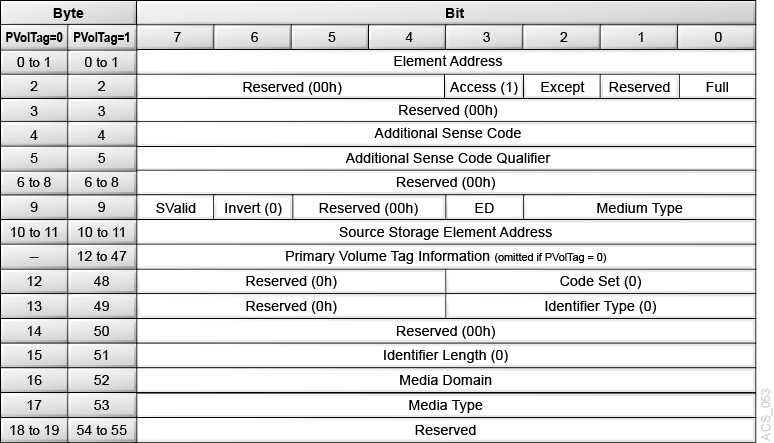Read Element Status (B8h)
The Read Element Status command (B8h) requests that the library return the status of the elements in the library.
Figure 3-19 Descriptor Block - Read Element Status (B8h)
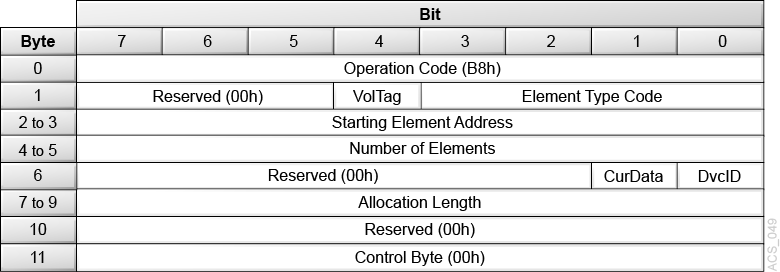
Description of "Figure 3-19 Descriptor Block - Read Element Status (B8h)"
- Vol Tag
-
0 = Volume Tag information is not reported
1 = Volume Tag information is reported
Volume Tag information can be returned in more than one format. All formats are left justified and padded with ASCII blanks through byte 32, bytes 33-36 are zero. The library does not support sequence numbers. The format to be used is configured using the GUI. Configurable formats include:
-
6-character — format
vvvvvv, where:vvvvvvis the ascii volser -
8-character Suffixed — format
vvvvvvdtorvvvvvvbt, where:vvvvvvis the ascii volserdis the media domainbis the an ascii blanktis the media type -
8-character Prefixed — format
dtvvvvvv orbtvvvvvv, where:dis the media domainbis the an ascii blanktis the media typevvvvvvis the ascii volser -
Open Format — the complete bar code as reported by the backing physical library.
-
- Element Type Code
-
0h = All Element Types reported. The element types are reported in ascending element address order, beginning with the first element greater than or equal to the Starting Element Address.
1h = Medium Transport Element (hand)
2h = Storage Element (cartridge tape storage cells)
3h = Import/Export Element (CAP cells and PTP cells)
4h = Data Transfer Element (tape drive)
- Starting Element Address
-
This field specifies the minimum element address to report. Only elements with an element address greater than or equal to the Starting Element Address are reported.
Element descriptor blocks are not generated for undefined element addresses.
The Starting Element Address must be a valid address for the library but does not have to be an address of the type requested in the Element Type Code.
- Number of Elements
-
This field represents the maximum number of element descriptors to be transferred. This is an actual number of element descriptors to be transferred, not an element address range.
- Cur Data
-
0 = Library operations are normal, and library mechanics may become active if needed to gather element static data.
1 = The library is responding with data only; no mechanical operations are active. The CurData bit is effectively ignored by the library. The library will perform or not perform mechanical operations to obtain proper information at its discretion independently of the setting of this bit.
- DvcID
-
0 = The library will not return device identification information.
1 = The library will return device identification information only for data transfer elements.
- Allocation Length
-
This field specifies the length in bytes of the space allocated by the initiator for the transfer of element descriptors. Only complete element descriptors are transferred. Element descriptors are transferred until one of the following conditions is met:
-
All available element descriptors of the type specified in the Element Type Code have been transferred.
-
The number of element descriptors specified in the Number of Elements field have been transferred.
-
There is less allocation length space available than required for the next complete element descriptor or header to be transferred.
-
- Read Element Status Data
-
The library returns data for a Read Element Status command with an eight-byte Element Status Data header, followed by one to four element pages, one page per element type.
A page consists of an eight-byte Element Status Page header, followed by one or more Element Descriptors. The format of the descriptor is based on the element type reported in this page. Each element type receives a separate Element Descriptor format.
Data can be truncated based on the length specified in the allocation field.
Element Status Data Header Definition
The library sends this header once for each Read Element Status command.
Figure 3-20 Descriptor Block - Element Status Data Header Definition

Description of "Figure 3-20 Descriptor Block - Element Status Data Header Definition"
- First Element Address Reported
-
This field indicates the lowest element address found of the type specified in the Element Type Codes and greater than or equal to the Starting Element Address.
- Number of Elements Available
-
This field indicates the number of elements found of the type specified in the Element Type Codes and greater than or equal to the Starting Element Address. This number is adjusted to be less than or equal to the count specified in the Number of Elements field in the
Read Element Statuscommand. - Byte Count of Report Available
-
This field indicates the number of bytes of element status data available for all elements meeting the requirements of the
Read Element Statuscommand. This count does not include the Element Status Data header bytes. This value is not adjusted to match the allocation length from the command.
Element Status Page Header
The library sends this header once for each type of element descriptors.
Figure 3-21 Descriptor Block - Element Status Page Header

Description of "Figure 3-21 Descriptor Block - Element Status Page Header"
- Element Type Code
-
See ""Element Type Code"" .
- PVolTag
-
0 = Volume Tag information has not been requested. The data is omitted from the element descriptors.
1 = Volume Tag information has been requested to be reported and is present.
- AVolTag
-
The library does not support alternative volume tags (AVolTag) and returns a value of 0.
- Element Descriptor Length
-
This field indicates the total number of bytes contained in a single element descriptor.
- Byte Count of Descriptor Data Available
-
This field indicates the total number of bytes of element descriptor data available for the elements of this element type that meet the requirements of the
Read Element Statuscommand. This count does not include the Element Status Page header bytes. This value is not adjusted to match the allocation length. - Element Descriptors
-
See below.
Element Descriptors
The following sections contain the field definitions for the four types of library elements, which are:
-
Medium Transport Element (the hand)
-
Storage Element (cartridge tape storage cells)
-
Import/Export Element (CAP cells and PTP cells)
-
Data Transfer Element (tape drives)
Each element descriptor includes the element address and status flags. Each element descriptor might also contain sense key information as well as other information, depending on the element type.
The element descriptors for the four types of elements are similar, with the exception of a few fields. Note the differences in Bytes 02, 06, and 07 for the four element descriptors.
The library does not support alternate volume tags. This information is not included in any of the element descriptors.
Medium Transport Element Descriptor
Medium transport elements are robotic components capable of physically moving cartridges. The Medium Transport Element Descriptor defines the robot characteristics.
Figure 3-22 Medium Transport Element Descriptor
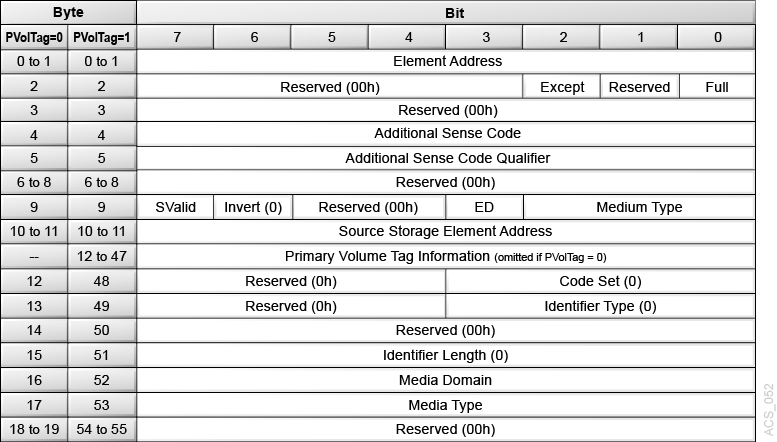
Description of "Figure 3-22 Medium Transport Element Descriptor"
Storage Element Descriptor
Storage elements are the main cartridge tape storage cells of the library.The Storage Element Descriptor describes a storage cell.
Import/Export Element Descriptor
Import/Export elements are the CAP and/or Pass-thru cells of the library. The Import/Export Element Descriptor describes a CAP cell.
Figure 3-24 Import/Export Element Descriptor
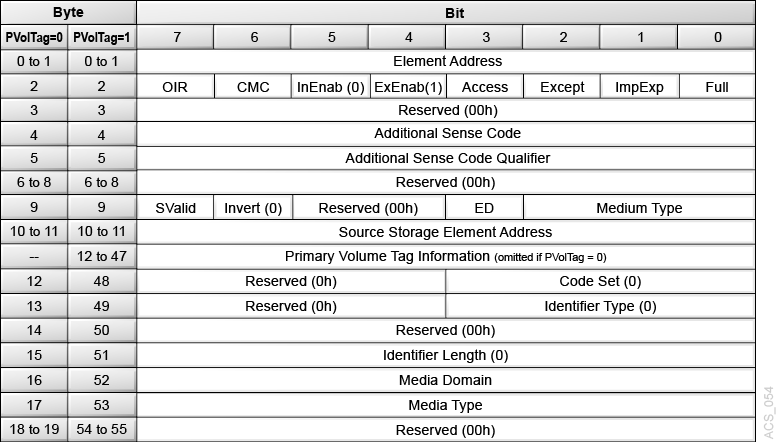
Description of "Figure 3-24 Import/Export Element Descriptor"
Data Transfer Element Descriptor
Data transfer elements are the tape drives in the library. The Data Transfer Element Descriptor Definitions page describes a tape drive.
Figure 3-25 Data Transfer Element Descriptor (DvcID = 0)
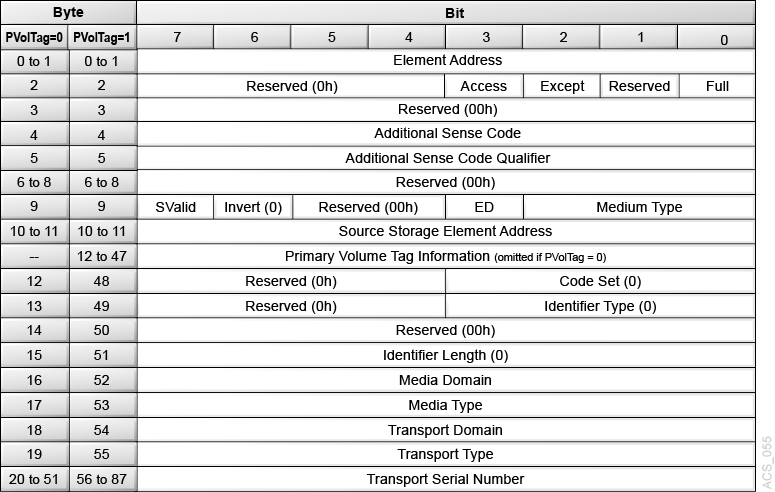
Description of "Figure 3-25 Data Transfer Element Descriptor (DvcID = 0)"
Figure 3-26 Data Transfer Element Descriptor (DvcID = 1)
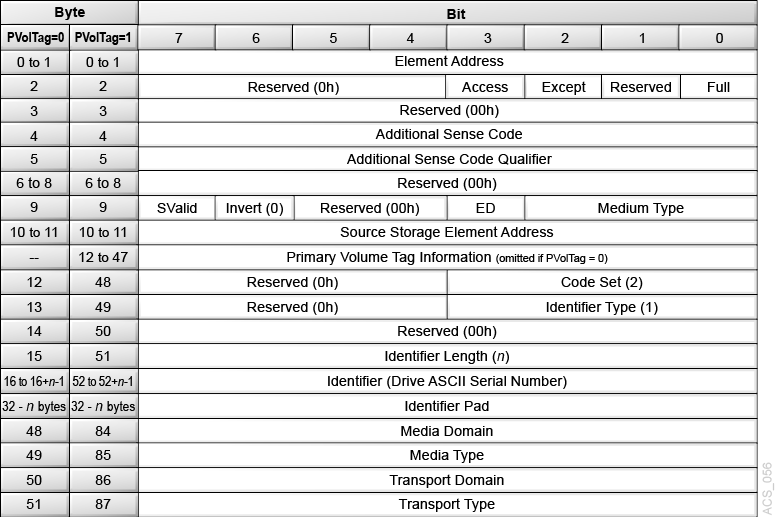
Description of "Figure 3-26 Data Transfer Element Descriptor (DvcID = 1)"
Element Descriptor Definitions
- Element Address
-
The address of the element (robot hand, cartridge cell, CAP cell, drive, or empty drive slot).
- OIR
-
0 = No operator intervention required to make the CAP accessible
1 = Operator intervention required to make the CAP accessible
- CMC
-
0 = The import/export element is a CAP. The cartridge will not leave the library when prevented by the Prevent/Allow Medium Removal (1Eh) command.
- InEnab
-
1 = The CAP supports importing cartridges.
- ExEnab
-
1 = The CAP supports exporting cartridges.
- Access
-
0 = The robot cannot access the element. For Import/Export elements, this can occur when the CAP is open or a CAP magazine was removed. For Data transfer elements, this can occur when a cartridge is loaded in a drive.
1 = The robot can access the element
- Except
-
0 = The element is in a normal state
1 = The element is in an abnormal state. The Additional Sense Code (ASC) and the Additional Sense Code Qualifier (ASCQ) fields contain information regarding the abnormal state. Other fields in the descriptor might be invalid and should be ignored.
- ImpExp
-
0 = The robot placed the cartridge in the CAP for an export operation.
1 = An operator placed the cartridge in the CAP for an import operation.
- Full
-
0 = The element does not contain a cartridge
1 = The element contains a cartridge
- ASC (Additional Sense Code)
-
This field is valid only if the Except bit is set. In the case of an exception, it contains an ASC as defined for Request Sense data.
- ASCQ (Additional Sense Code Qualifier)
-
This field is valid only if the Except bit is set. In the case of an exception, it contains an ASCQ as defined for Request Sense data.
Condition ASC Value ASCQ Value CAP Open
3Ah
02h
Empty Drive Slot (no drive installed)
3Bh
1Ah
Drive Hardware Error
40h
02h
- SValid
-
0 = The Source Element Address and Invert fields are not valid.
1 = The Source Element Address and Invert fields are valid.
- Invert (not supported)
-
0 = The library does not support multi-sided media.
- ED
-
0 = The element is enabled.
1 = The element is disabled (for example an open CAP, a drive hardware error, or empty drive slot).
- Medium Type
-
The type of medium currently present in the element as determined by the medium changer.
0h = Unspecified - the medium changer cannot determine the medium type.
1h = Data Medium
2h = Cleaning Medium
- Source Storage Element Address
-
This field is valid only if the SValid field is 1. This field provides the address of the last storage element this cartridge occupied. The element address value may or may not be the same as this element.
- Primary Volume Tag Information
-
When PVolTag is 1, the library returns volume tag information. When PVolTag is 0, the library omits volume tag information.
The Primary Volume Tag field contains the null-terminated ASCII barcode label on the tape cartridge. If the label on the cartridge tape is not readable or if the element is empty, the Primary Volume Tag field is filled with 36 bytes of zeros. The "Volume Label Format" controls the presentation of the volser in the Primary Volume Tag field. The library supports the following settings:
-
Full Label
-
No Type Checking
-
Prepend Last Two Characters
-
Trim Last Character
-
Trim Last Two Characters
-
Trim First Two Characters
-
Trim First Character
For more information, see the SL4000 GUI help.
-
- Code Set
-
0h = Reserved (not supported) for the Medium Transport Element, Storage Element, Import/Export Element, or Data Transfer Element (DvcID = 0) descriptors.
2h = The identifier contains ASCII graphic codes (code values 20h through 7Eh) for Data Transfer Element (DvcID = 1) descriptor.
- Identifier Type
-
The format and assignment authority for the identifier.
0h = The library returns vendor specific data.
- Identifier Length
-
The combined length of the Identifier and the Identifier Pad.
00h = The library returns 0 bytes of identifier data in the descriptors for Medium Transport Elements, Storage Elements, Import/Export Elements, or Data Transfer Elements (DvcID = 0).
20h = The library returns 32 bytes of identifier data for the Data Transfer Element (DvcID = 1).
- Identifier (for Data Transfer Element DvcID = 1 Only)
-
The ASCII Serial Number for the tape drive associated with this data transfer element.
- Identifier Pad (for Data Transfer Element DvcID = 1 Only)
-
Contains ASCII blanks. The number of blanks depends on the length of the Identifier field. The combined length of the Identifier field and the Identifier Pad is 32 bytes.
- Media Domain
-
43h ('C') = The element contains a cleaning cartridge.
4Ch ('L') = The element contains an LTO cartridge.
54h ('T') = The element contains a T10000 cartridge.
FFh = The media domain cannot be determined or the element is empty.
- Media Type
-
FFh = The media type cannot be determined or the element is empty.
If the Media Domain is 43h (C):
-
C = The element contains a T10000 Version 2 cleaning cartridge
-
L = The element contains a T10000 Universal cleaning cartridge.
-
T = The element contains a T10000 Version 1 cleaning cartridge.
-
U = The element contains a Universal LTO cleaning cartridge.
If the Media Domain is 4Ch (L):
-
3 = The element contains a 400 GB Generation 3 LTO cartridge.
-
4 = The element contains an 800 GB Generation 4 LTO cartridge.
-
5 = The element contains a 1.5 TB Generation 5 LTO cartridge.
-
6 = The element contains a 2.5 TB Generation 6 LTO cartridge.
-
7 = The element contains a 6 TB Generation 7 LTO cartridge.
-
8 = The element contains a 12 TB Generation 8 LTO cartridge.
-
9 = The element contains a 18 TB Generation 9 LTO cartridge.
-
T = The element contains a 400 GB Generation 3 LTO WORM cartridge.
-
U = The element contains an 800 GB Generation 4 LTO WORM cartridge.
-
V = The element contains a 1.5 TB Generation 5 LTO WORM cartridge.
-
W = The element contains a 2.5 TB Generation 6 LTO WORM cartridge.
-
X = The element contains a 6 TB Generation 7 LTO WORM cartridge.
-
Y = The element contains a 12 TB Generation 8 LTO WORM cartridge.
-
Z = The element contains an 18 TB Generation 9 LTO WORM cartridge.
If the Media Domain is 54h (T):
-
1 = The element contains a T10000 Version 1 cartridge.
-
2 = The element contains a T10000 Version 2 cartridge.
-
S = The element contains a T10000 Version 1 Sport cartridge.
-
T = The element contains a T10000 Version 2 Sport cartridge.
-
- Transport Domain
-
4Ch (L) = The drive supports LTO cartridges.
54h (T) = The drive supports T10000 cartridges.
FFh = The element domain cannot be determined.
- Transport Type
-
FFh = The type cannot be determined.
If the Transport Domain is 4Ch (L):
-
3Bh = HP Generation 5 LTO drive
-
3Ch = IBM Generation 5 LTO drive
-
3Dh = HP Generation 6 LTO drive.
-
3Eh = IBM Generation 6 LTO drive.
-
2Dh = IBM Generation 7 LTO drive.
-
2Eh = IBM Generation 8 LTO drive.
-
46h = IBM Generation 9 LTO drive.
If the Transport Domain is 54h (T):
-
0Dh = StorageTek T10000A drive.
-
0Eh = StorageTek T10000A drive in 3590 emulation mode.
-
18h = StorageTek T10000A Encrypting drive.
-
19h = StorageTek T10000A Encrypting drive in 3590 emulation mode.
-
1Ah = StorageTek T10000B drive.
-
1Bh = StorageTek T10000B drive in 3590 emulation mode.
-
1Ch = StorageTek T10000B Encrypting drive.
-
1Dh = StorageTek T10000B Encrypting drive in 3590 emulation mode.
-
22h = StorageTek T10000C drive.
-
23h = StorageTek T10000C drive in 3590 emulation mode.
-
24h = StorageTek T10000C Encrypting drive.
-
25h = StorageTek T10000C Encrypting drive in 3590 emulation mode.
-
26h = StorageTek T10000D drive.
-
27h = StorageTek T10000D drive in 3590 emulation mode.
-
28h = StorageTek T10000D Encrypting drive.
-
29h = StorageTek T10000D Encrypting drive in 3590 emulation mode.
-
2Ah = StorageTek T10000D Fibre Channel over Ethernet.
-
2Bh = StorageTek T10000D Fibre Channel over Ethernet Encrypting drive.
-
- Transport Serial Number
-
The 32-byte ASCII serial number for the drive.
For drives with a serial number less than 32 bytes, the library left-justifies the value by returning ASCII blanks for the unused less-significant bytes. If the serial number is not available from a drive that should support an ASCII serial number, the library returns all ASCII blanks.
